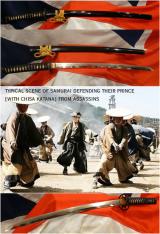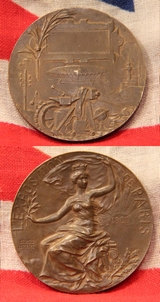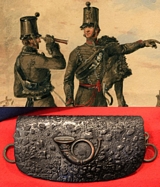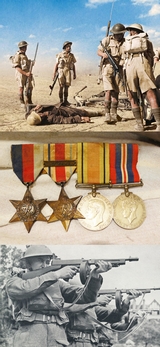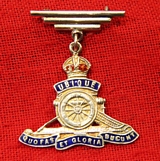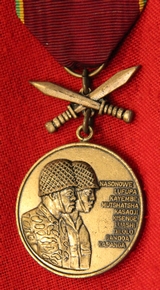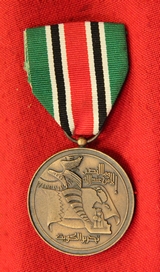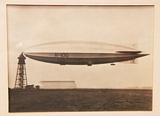A Japanese Chisa Katana by Master Smith Hoki no kami Fujiwara Hirotaka
This is a delightful sword that would make a superb start to any fine collection of antique weaponry, a future heirloom for generation to come. It has a superb Japanese elegance in its quiet traditional samurai simplicity. Its overall condition and appearance is very fine indeed and would complement any elegant décor or surroundings.
Signed blade under the hilt tsuka, Hoki no kami Fujiwara Hirotaka
A highly rated early Shinto master smith Hoki no Kami Fujiwara Hirotaka was working in 1655 at Echizen province.
He was very skilful swordsmith most highly rated, and was making his swords like this one in the Kanemoto style.
Hirotaka was part of the so-called Echizen Shimohara Ha. Circa 1655, His working date, according to Fujishiro is Meireki period (1655-57) and he rates Hirotaka blades as ‘wazamono’ for their incredible sharpness and Chujosaku. Fujishiro states first he had the title of Hoki (no) Daijo and Hoki (no) Kami as in this example. He continues to state his work is similar to that of Harima Daijo Shigetaka and that these smiths co-operated in gassaku work. The blade is in around 90 to 95% of its original condition Edo polish, and very nice indeed with just a few surface marks. All the fittings are original Edo era, and are decorated with sea shell designs, and an o-sukashi deeply pierced Higo tsuba is Koto period, circa 1500. The chisa katana was able to be used with one or two hands like a katana (with a small gap in between the hands) and especially made for double sword combat a sword in each hand. It was the weapon of preference worn by the personal Samurai guard of a Daimyo Samurai war lord clan chief, as very often the Daimyo would be often likely within his castle than without. The chisa katana sword was far more effective as a defence against any threat to the Daimyo's life by assassins or the so-called Ninja when hand to hand sword combat was within the castle structure, due to the restrictions of their uniform low ceiling height. But in trained hands this sword would have been a formidable weapon in close combat conditions, when the assassins were at their most dangerous. The hilt was usually around ten to eleven inches in length, but could be from eight inches or up to twelve inches depending on the Samurai's preference. Chisa katana, Chiisagatana or literally "short katana", are shoto mounted as katana. It is fair to say wakizashi are shoto which are mounted in a similar way to katana, but in this instance we are considering the predecessors of the daisho. In the transitional period from tachi to katana, katana were called "uchigatana", and shoto were referred to as "koshigatana" and "chiisagatana", in many cases quite longer than the later more normal length wakizashi. A blade of this quality reflects the status of the lord or prince whose life it defended. The saya is in delightful quality high-polish finished traditional lacquer, with just slight age markings from the previous century. The saya is of original age so it displays a very slight element of looseness caused by hundreds of blade withdrawals, made in its lifetime. Overall 35 inches long, blade tsuba to tip 22.25 inches, tsuka 9.5 inches long. read more
Price
on
Request
Bronze L'Exposition de Paris 1900 Commemorative Medal;
Santos Dumont dirigible / airship, Obverse: relief of a robed female figure depicted, embossed text "L'EXPOSTION DE PARIS 1900"
Reverse: relief of electric power lines, Santos Dumont dirigible, and steel battleship depicted. Condition: very good
Dimension: 55mm. Another example is Inventory Number
A19640401000 part of the collection of the National Air and Space Museum, the Smithsonian. Santos Dumont's first airship was his No. 1 (airship) ? First flown on 18 September 1898. Had a cylindrical envelope with conical ends containing a ballonet connected to an air pump: 25 m (82 ft) long, 3.5 m (11 ft 6 in) diameter, 180 m3 (6,400 cu ft) capacity. A square basket was suspended from wooden battens contained in pockets in the envelope, and a silk-covered rudder fitted behind and above the basket. Powered by a De Dion-Bouton tricycle engine (modified to have tandem cylinders) of 3 hp which was mounted outside and in front of the basket driving a small two bladed propeller. Fore and aft trim was achieved by moving a pair of ballast bags. Manoeuvred well, but the ballonet was too small to retain the necessary rigidity of the envelope, and loss of pressure caused it to be wrecked on its second flight on 20 September, from then he made another 10 versions and improvements of it. He also made his first helicopter in 1905 read more
120.00 GBP
Victorian Crimean War Period Light Infantry Crossbelt Pouch
Black leather foul weather pouch with coiled horn bugle for the Light Division regiments. Opens to reveal a pouch for despatches and small documents, sovereigns etc. Small leather reataining tab lacking. The Light Division was a light infantry division of the British Army. Its origins lay in "Light Companies" formed during the late 18th century, to move at speed over inhospitable terrain and protect a main force with skirmishing tactics. These units took advantage of then-new technology in the form of rifles, which allowed it to emphasise marksmanship, and were aimed primarily at disrupting and harassing enemy forces, in skirmishes before the main forces clashed.
Formed in 1803, during the Napoleonic Wars, the Light Division was raised thrice thereafter: during the Crimean War, the First World War and from 1968 to 2007. Some light infantry units remained outside the Light Division. A Light Division was again formed for service, but this was in name only as no light infantry battalions were assigned to it. The division was involved in the Battle of the Alma (20 September 1854), which is usually considered the first battle of the Crimean War, took place in the vicinity of the River Alma in the Crimea. An Anglo-French force under General St. Arnaud and Lord Raglan defeated General Menshikov's Russian army, which lost around 6,000 troops. They were also engaged in the Siege of Sevastopol (1854?1855), and the battle of Battle of Inkerman (5 November 1854) before the end of hostilities. read more
265.00 GBP
A Good Original 'Desert Rat' British WW2 British Infantry 4 Medal Group
From a former Desert Rat veteran of the 8th Army. Acquired with his helmet but sold separately. He fought Rommel's Afrika Korps, [who, under Montgomery's command, kicked the DAK's bottoms at El Alamein] and then with the 8th Army transferred to Italy in order to fight from the south right through to Rome, however, the owner of this medal group and helmet was severely wounded before he qualified for the Italy Star medal, however, he did get the Afrika Star with 8th Army bar, plus his other 3 medals. The Eighth Army was a field army formation of the British Army during the Second World War, fighting in the North African and Italian campaigns. Units came from Australia, British India, Canada, Free French Forces, Greece, New Zealand, Poland, Rhodesia, South Africa and the United Kingdom.
Significant formations which passed through the Army included V Corps, X Corps, XIII Corps, XXX Corps, I Canadian Corps and the II Polish Corps. On 26 November the Commander-in-Chief Middle East Command, General Sir Claude Auchinleck, replaced Cunningham with Major-General Neil Ritchie, following disagreements between Auchinleck and Cunningham. Despite achieving a number of tactical successes, Rommel was forced to concede Tobruk and was pushed back to El Agheila by the end of 1941. In February 1942 Rommel had regrouped his forces sufficiently to push the over-extended Eighth Army back to the Gazala line, just west of Tobruk. Both sides commenced a period of building their strength to launch new offensives but it was Rommel who took the initiative first, forcing the Eighth Army from the Gazala position.
Ritchie proved unable to halt Rommel and was replaced when Auchinleck himself took direct command of the army. The Panzer Army Afrika were eventually stopped by Auchinleck at the First Battle of El Alamein. Auchinleck, wishing to pause and regroup the Eighth Army, which had expended a lot of its strength in halting Rommel, came under intense political pressure from British Prime Minister Winston Churchill to strike back immediately. However, he proved unable to build on his success at Alamein and was replaced as Commander-in-Chief Middle-East in August 1942 by General Harold Alexander and as Eighth Army commander by Lieutenant-General William Gott. Gott was killed in an air crash on his way to take up his command and so Lieutenant-General Bernard Montgomery was appointed in his place. Alexander and Montgomery were able to resist the pressure from Churchill, building the Army's strength and adding a pursuit formation, X Corps, to the Army's XIII and XXX Corps.
At the beginning of November 1942 the Eighth Army defeated Rommel in the decisive Second Battle of El Alamein, pursuing the defeated Axis army across Libya and reaching the Mareth defensive line on the Tunisian border in February 1943, where it came under the control of 18th Army Group. The Eighth Army outflanked the Mareth defences in March 1943 and after further fighting alongside the British First Army, the other 18th Army Group component which had been campaigning in Tunisia since November 1942, the Axis forces in North Africa surrendered in May 1943 read more
175.00 GBP
Zaire Awarded Congo Medal 1977,Operation Shaba
To a French special advisor to the Zaire military. Zaire, Military Merit Medal, Operation Shaba I. Shaba I was a conflict in Zaire's Shaba (Katanga) Province lasting from March 8, 1977, to May 26, 1977. The conflict began when the Front for the National Liberation of the Congo (FNLC), a group of about 2,000 Katangan Congolese soldiers (veterans of the Congo Crisis, the Angolan War of Independence, and the Angolan Civil War) crossed the border into Shaba from Angola. The FNLC made quick progress through the region, due to sympathizing locals and to the disorganization of the Zairian military (Forces Arm?es Za?roises, or FAZ). Traveling east from Zaire's border with Angola, the rebels reached Mutshatsha, a small town near to the key mining town of Kolwezi.
President Mobutu Sese Seko of Zaire accused Angola, East Germany, Cuba, and the Soviet Union of sponsoring the rebels. Motivated by anti-Communism and by economic interests, the Western Bloc and China sent assistance to support the Mobutu regime. The most significant intervention, orchestrated by the Safari Club, featured a French airlift of Moroccan troops into the war zone. This intervention turned the tide of the conflict. U.S. President Jimmy Carter approved the shipment of supplies to Zaire, but refused to send weapons or troops and maintained that there was no evidence of Cuban involvement read more
65.00 GBP
Medal for the Liberation of Kuwait, 1991, Wisam al-Tahrir al-Kuwait, AH1411
Circular bronze medal with laterally-pierced ball for ribbon suspension; the face with a map of Kuwait imposed on the Bahraini flag, a flaming sun above left, a winged ribbon rising like a whirlwind from the Kuwait Towers, an inscription in Arab characters above right and below; the reverse with the crowned emblem of Bahrain, palm leaves to either side, an inscription in Arab characters above and below; on original ribbon with brooch bar mounted with pin for wear. The medal was instituted by Emir Isa bin Salman al Khalifa in 1991 to be awarded to members of Bahrain's military who served during the First Gulf War. Although Bahrain was the main naval base for Coalition forces and a major base for air operations, the number of its military was relatively small. A good example. read more
65.00 GBP
Framed Original Photo of His Majesty's Airship R100,
His Majesty's Airship R100, known simply as R100, was a privately designed and built British rigid airship made as part of a two-ship competition to develop a commercial airship service for use on British Empire routes as part of the Imperial Airship Scheme. The other airship, the R101, was built by the British Air Ministry, but both airships were funded by the Government.
R100 was built by the Airship Guarantee Company, a specially created subsidiary of the armaments firm Vickers-Armstrongs, led by Commander Dennis Burney. The design team was headed by Barnes Wallis, later famous for his invention of the bouncing bomb and Knighted by the King. David Hawkins Senior, formerly of our family business, was Sir Barnes Wallis's bodyguard during his time that he served in the RAF. The design team also included Nevil Shute Norway as the senior stress engineer.
R100 first flew in December 1929. It made a series of trial flights and a successful return crossing of the Atlantic in July?August 1930, but following the crash of R101 in October 1930 the Imperial Airship Scheme was terminated and R100 was broken up for scrap. We show [for illustration only] a photo R100 over Canadian Bank of Commerce building in Toronto, Canada, then the highest building in the British Empire (August 1930). read more
135.00 GBP
Original Mounted Photograph of HM Airship Parseval PL18 In 1913
Photographed at Farnboro. Maiden flight: 23. April 1913
1913 delivered to the English Navy, under the marking "Parseval No.4". The Royal Navy described its service as very successful
Length: 80 m; diameter: 15 m; volume: 8800 m?.
Power plant: 2x 132 kW (180 PS) Maybach-engines, max speed 68 km/h,
Crew: 2 officers and 7 men. Radio and Weaponry installed
Served during the World War I first with the BEF then on the Western Front as a patrol ship, she was demobilised by the Royal Navy in July 1917. The original mounting card has some foxing but the photo has none and is good. Hand written in pencil on the mount. Dated 1913. Photo 19 x 24 cm, mount size 38 x 30cm read more
180.00 GBP
French Medal Commemorating the Universal Exhibition in Paris,1855. E.Oudine
A large, original, mid 19th century French metal medal of beautiful quality made in 1855. Laureate bust of Napoleon III left. NAPOLEON III EMPEREUR (Obverse by E.A. Oudin?) Reverse: Three allegorical figures. EXPOSITION UNIVERSELLE In exergue: LA FRANCE COURONNE / L'ART ET INDUSTRIE (Reverse by A.A. Caqu?) 6.83 cm diameter. A near identical example in the Royal Collection Trust number;RCIN 444908
AA Caqu? (medallist) and E.Oudine
Napol?on III, Emperor of the French, 3rd son of Lodewyk I, King of Holland (1808-73)
Exposition Universelle (1855 : Paris) Very crisp example in nice condition, two very small edge nicks on the reverse. Exactly ten years before the opening of the first universal exposition in Paris, the future father of the event was serving a lifetime prison term in the state military fortress at Ham. Charles Louis Napol?on Bonaparte, nephew and adopted godson of the Emperor, had failed in his second attempt at a coup d'?tat against the restored monarchy of Louis Philippe. After the first attempt in 1836, the government had exiled him to America. The second attempt in 1840 earned him the detention term at Ham, behind the very walls that, over four centuries before, had held Joan of Arc captive. Many monarchists and conservatives in the Court of Peers and the National Assembly wished for terminal punishment; but the name of Napol?on was in the ascendant once again throughout France. On the very day when Charles Louis was sentenced, Emperor Napol?on's ashes were received by both royalty and the multitudes of Paris with great pomp at the church of Les Invalides. And so, rather than arouse the wrath of the still considerable number of Bonapartists, the Court of Peers determined to make the military fortress at Ham the Elba of Charles Louis. In spite of a decree banning the Bonaparte family from France forever, Charles was elected in absentia to the Assembly. He skillfully parlayed his popularity, and the halo of glory around the name Napol?on, into the presidency of the National Assembly in 1848. After a parliamentary struggle with the retreating forces ? supporters of the monarchy and revolutionaries who wished France to become a republic ? Charles Louis took command of the army and forcibly dismissed the assembly. He was proclaimed Emperor of the French on December 1, 1851. read more
195.00 GBP


